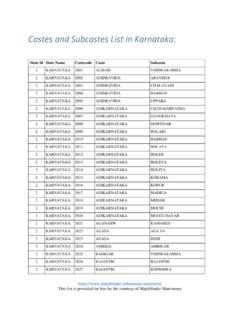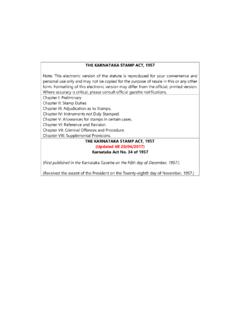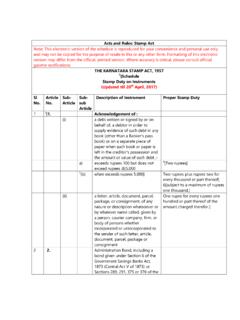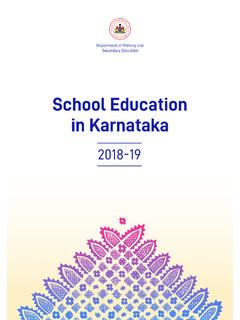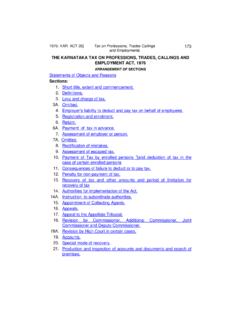Transcription of FLORA OF KARNATAKA
1 FLORA OF KARNATAKAA ChecklistVolume - 2 : Gymnosperms & Angiosperms CITATIONK arnataka Biodiversity Board, 2019. FLORA OF KARNATAKA , A Checklist, Volume 2: Gymnosperms and Angiosperms. 1 - 1002 (Published by KARNATAKA Biodiversity Board)Published: December, - 978-81-939228-1-1 KARNATAKA Biodiversity Board, 2019 ALL RIGHTS RESERVED No part of this book, or plates therein, may be reproduced, stored in a retrieval system or transmitted, in any form or by any means, electronic, mechanical, photocopying recording or otherwise without the prior permission of the publisher. This book is sold subject to the condition that it shall not, by way of trade, be lent, re-sold, hired out or otherwise disposed of without the publisher s consent, in any form of binding or cover other than that in which it is published.
2 The correct price of this publication is the price printed on this page. Any revised price indicated by a rubber stamp or by a sticker or by any other means is incorrect and should be THE CONTENTS INCLUDING TEXT, PLATES AND OTHER INFORMATION GIVEN IN THE BOOK ARE SOLELY THE AUTHOR S RESPONSIBILITY AND BOARD DOES NOT HOLD ANY :` 2000/- (Two thousand rupees only).Printed by :Peacock Advertising India Pvt Ltd. # 158 & 159, 3rd Main, 7th Cross, Chamarajpet, Bengaluru 560 018 | Ph: 080 - 2662 0566 Web: FOREWORDA bout 60% of the Western Ghats is present in KARNATAKA State, with this large part of the peninsular green cover coupled with inland forest plateau enriched by the seven river systems, the State of KARNATAKA showcases a wider floral wealth harboring highest number of apex predators all of which is conserved by a framework of various statutes.
3 The present book titled FLORA of KARNATAKA A checklist of Angiosperms & Gymnosperms, Volume 2 gives a concise information on the present day seed-bearing plants - the Angiosperms - with highest number of species while also capturing information on the old world naked seed bearing plants the Gymnosperms - which are the tallest and largest living plants on earth. These plants have the natural ability to produce seeds surrounded by nutritive tissue and coated with a seed coat. Gymnosperm plants were present 200 million years before the arrival of the Angiosperms, they have somehow acclimatized and managed to survive hitherto with a few countable specimens. On the other hand, the Angiosperms are the successors of Gymnosperms and are the modern day flower bearing plants, serving mankind with various uses especially as food and medicine.
4 The contributions and services of experts engaged in formulating the methodology and compiling this huge data is praise worthy. The book not only provides an exhaustive list of plants from the above two groups, but also contains information on their taxonomy, synonyms, habitat including their distribution as well. I would like to acknowledge KARNATAKA Biodiversity Board for its substantiating efforts in preparation of this Dr. M. Sanjappa, INSA Senior Scientist, Mahatma Gandhi Botanical Garden, GKVK, Bengaluru 560 Dr. Sringeswara, Curator, Mahatma Gandhi Botanical Garden, GKVK, Bengaluru 560 CreditsDr. M. Sanjappa, Sringeswara, Yadav, Shivaji University, Sri Sahai, IFS (Retd.), Former Chairman, KARNATAKA Biodiversity Board for his vision which resulted in this Sri Singh, IFS, APCCF (Working Plan) & Former Member Secretary, KARNATAKA Biodiversity Board for initiating the Dr.
5 M. Sanjappa, INSA Senior Scientist, Mahatma Gandhi Botanical Garden, GKVK for taking the lead in gathering the Dr. Virender Singh, IFS, APCCF & Member Secretary, KARNATAKA Biodiversity Board for compiling the information and Smt Sahana S. Hegde, Deputy Director (Horticulture), KARNATAKA Biodiversity Board for facilitation and convening the Sri Pritham S, Research Associate (Zoology), KARNATAKA Biodiversity Board for coordination and cover page Members of Publication Committee, KARNATAKA Biodiversity Board for various inputs and suggestions:a)Dr. M. Sanjappa, INSA Senior Scientist, Mahatma Gandhi Botanical Garden, GKVK, Bengaluru 560 )Prof. C. Kameswara Rao, Executive Secretary, FBAE, No. 1 Gupta s layout, Southend Road, Bengaluru 560 )Prof.
6 M. Narayana Swamy, Professor & Head, Dept. of Veterinary Physiology, Veterinary College, Hebbal, Bangalore 560 )Dr. Hegde, Former Professor & Chairman, Dept. of Zoology, University of Mysore, No. 109, Vikasa, 7th Main, 3rd Cross, Bogadi II Stage, Mysore 570 )Dr. Manjunatha, Professor of Agricultural Extension and Editor, Communication Centre, UAS, GKVK, Bengaluru 560 )Smt Sahana S. Hegde, Deputy Director (Horticulture), KARNATAKA Biodiversity Board, Malleshwaram, 18th Cross, Bengaluru 560 Sringeswara, Curator, Mahatma Gandhi Botanical Garden, GKVK, Bengaluru 560 065 for preparation of index, photo plates & proof readingComposition of the BoardThe present Board has been constituted vide order No: FEE 203 ENV 2016, Bengaluru. Dated: NoBoard MembersDesignation1 Sri Ananth Hegde Ashisara, Chairman, KARNATAKA Biodiversity Board, Ground Floor, thVanavikas, 18 Cross, Malleshwaram, Bengaluru 560 Sandeep Dave, IAS, Additional Chief Secretary to Government, Forest, Ecology and Environment Department, MS Building, Bengaluru 560 Member3 Sri Vijay Kumar Gogi, IFS, Principal Secretary to Government, Forest, Ecology and Environment Department, MS Building, Bengaluru 560 Member4 Sri Rajender Kumar Kataria, IAS, Secretary to Government, Department of Agriculture, MS Building 560 Member5 Sri Punati Sridhar, IFS, Principal Chief Conservator of Forests (HoFF)
7 , Aranya Bhavan, th18 Cross, Malleshwaram, Bengaluru 560 Member6 Smt Meenakshi Negi, IFS, Commissioner, Department of AYUSH, Dhanvantari Road, Ananda Rao Circle, Bengaluru 560 Member7Dr. C. G. Kushalappa, Dean Forestry, University of Agriculture and Horticultural Sciences (Shivamogga), College of Forestry (Ponnampet), Kunda Road, Ponnampet 571 Member8Dr. M. Mahadeva Murthy, Professor, Dept. of Forestry and Environmental Science, UAS, GKVK, Bengaluru 560 Member9Dr. Jayakara Bhandary M, Associate Professor, Dept. of Botany, Government First Grade College, Car Street, Mangaluru 575 Member10 Prof. M. Narayana Swamy, Professor & Head, Dept. of Veterinary Physiology, Veterinary College, Hebbal, Bengaluru 560 Member11Dr. Niranjana Murthy, Professor & Scheme Head, AICRP on Potential Crops, RIOF Building, UAS, GKVK, Bangalore 560 Member12 Smt Anita K.
8 Arekal, IFS, Additional Principal Chief Conservator of Forests (Social thForestry), Aranya Bhavan, 18 Cross, Malleshwaram, Bengaluru 560 Invitee13 Sri Khanapure, Drugs Controller, Drugs Control Department Palace Road, Near KARNATAKA Public Service Commission, Bengaluru 560 Invitee14Dr. Virender Singh, IFS, Member Secretary, KARNATAKA Biodiversity Board, Ground Floor, thVanavikas, 18 Cross, Malleshwaram, Bengaluru 560 Secretary - ConvenerFlora of KARNATAKA , A ChecklistVolume 2 : Gymnosperms & Gymnosperms of KARNATAKA A - 6M. Sanjappa2. Angiosperms of KARNATAKA A - 815M. Sanjappa & A. N. Sringeswara3. - 1002 Page SanjappaMahatma Gandhi Botanical GardenUniversity of Agricultural Sciences, GKVK, Bengaluru 560 065 Gymnosperms of KARNATAKA A ChecklistSupport byKarnataka Biodiversity BoardINTRODUCTIONThe angiosperms and gymnosperms are together called Spermatophytes or seed bearing plants.
9 Gymnosperms (literally means naked seeds , in Greek gymnos meaning naked and sperma seed ) are a group of seed bearing plants and are called naked seeded plants, unlike angiosperms in which the seeds are covered or enclosed by fruits. In gymnosperms seeds are generally borne in the form of cones or rarely solitary as in Ginkgo biolba. Charecteristically the roots of some genera are known to be associated with mycorrhiza as in Pinus and in some Cycas species the specialised roots called corolloid roots have associated nitrogen fixing cynobacteria. The gymnosperms bear a variety of characteristic leaves mostly needle-like with thick cuticles, flat triangular scale-like, broad strap-shaped. The leaves of Cycads appear like palm leaves and those of Gnetum like those of dicotyledonous angiosperms.
10 The reproductive structures are called a strobilus or a cone. The male and female cones are always distinct, either borne on the same plant or on separate plants. The gymnosperms are represented by 12 families (under 4 subclasses and 8 orders), 83 known genera with ca 1080 known species (Christenhusz, ,Reveal, , Farjon, A., Gardner, , Mill, & Chase, 2011. A new classification and linear sequence of extant gymnosperms. Phytotaxa 19: 55 70.) distributed throughout the globe. Economically gymnosperns are very important, the conifers yield timber, resins, paper pulp, etc. and are used as raw materials in industry for producing a variety of products. Many species (of Amentotaxus, Taxus, Ginkgo, Ephedra, Pinus, Cupressus, Juniperus, etc.) are also used in various systems of medicine.
